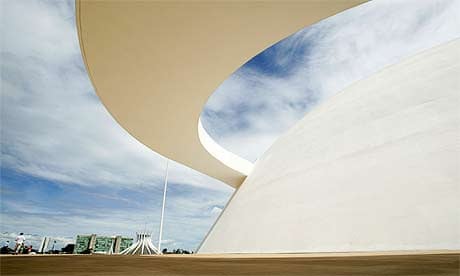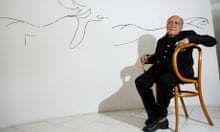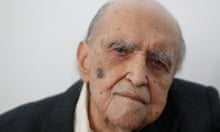It was the spectacular creation of a modern utopia: in the heart of a continent, built from scratch with daring architecture and urban planning, arose a city like no other.
Unveiled almost half a century ago, Brasilia astonished the world. Brazil's purpose-built capital of perfect grids and avant garde buildings exuded wonder and optimism, control and beauty.
The then president, Juscelino Kubitschek, hailed a new dawn for his country and the United Nations designated the city a world heritage site. It was a living, futurist museum.
As the 50th anniversary approaches, however, the future seems to have ambushed Brasilia. What was supposed to be a shiny citadel with huge attention to detail and organisation has in places degraded into a violent, crime-ridden sprawl of cacophonous traffic jams. The real Brazil has spilled into its utopian vision.
That is the bittersweet verdict of Oscar Niemeyer, the legendary architect who designed many of the city's civic monuments and is a keeper of its original flame. In a rare interview Niemeyer, now 100 and still professionally active, told the Guardian that his masterpiece was out of control.
"The way Brasilia has evolved, it has problems. It should have stopped growing some time ago. Traffic is becoming more difficult, the number of inhabitants has surpassed the target, limits are being exceeded."
Instead of 500,000 people as planners envisaged, the population has ballooned to 2.2 million, choking infrastructure and, in the rundown outskirts, ushering in scenes of gang violence more commonly associated with the favelas of Rio de Janeiro. Some areas have been nicknamed the baixada federal, invoking the baixada fluminese, Rio's most homicidal region.
Niemeyer, considered by many the world's greatest living architect, defends the city's conception and his designs for landmarks such as the cathedral, national congress and palace of justice. "There is no other place like Brasilia." But he laments the unplanned growth. "The city should call a halt."
It is an ironic appeal given that Brasilia was built at breakneck speed. The dream of moving the capital from Rio on the Atlantic coast to the centre of the country had existed for over a century but Kubitschek pursued it with urgency. Building started in 1956 and the new capital, along with a surrounding area known as the federal district, was inaugurated just 41 months later, in April 1960.
Commercial and residential zones were meticulously demarcated. Cars zipped along wide highways past buildings that projected simplicity and modernity with fine lines and waves.
Less fine were the subsequent waves of migration and lines of jobless people. The population surge aggravated problems of access to healthcare and education.
A recent study by the University of Brasilia found that unemployment among the city's youth had jumped from 21% in 1992 to around 40% in 2003.
Even more dramatic has been the rise in crime, especially on the outskirts.
Plinio Araujo, the mayor of Cidade Ocidental, an impoverished and gritty town in neighbouring Goias state, described the suburbs of the federal district as a "pressure cooker" which, if action was not taken, would "explode over the Alvorada Palace", the presidential residence which is the centrepiece of Niemeyer's creation.
Over 100 members of an elite security force were recently dispatched to the outskirts of the federal district and Goias to try to control the violence.
The country was especially shaken by the shooting of Amaury Ribeiro Junior, an investigative journalist from the Estado de Minas newspaper. He had just published a series of articles called Trafficking, Extermination and Fear, based on undercover work in violent neighbourhoods just outside the federal district in Goias. He had returned to the area to research a follow-up story on sexual violence in the so-called Entorno, an impoverished belt of around 30 towns that flanks Brazil's capital.
A teenager with a 38mm revolver fired three shots at the 44-year-old reporter as he sat in a bar waiting for a contact, hitting him once. It was never clear whether Ribeiro, who survived, was targeted because of his work or if he was the victim or a hold-up gone wrong.
"The place where I was shot is 15km from where the president sits in his palace," said Ribeiro. "It really is like the wild west; and what shocked me most was that so close to the capital you have such barbarity."
He said the high levels of violence were the result of huge migration to the region and an almost total absence of social services or policing. "The parents go to work in the capital and their kids are abandoned and end up being co-opted by drug traffickers."
But despite the disappointments, Brasilia's utopian dream is not completely dead. Residents say they never tire of gazing at the city centre's sublime, otherworldly architecture. Parents say it remains a better, safer place for children than Rio or Sao Paulo.
And Niemeyer, the man who made the dream concrete, speaks of the city like the proud father of a wayward but cherished offspring. In his Rio studio overlooking Copacabana beach he displays the design of a tower with two viewing platforms which he has been commissioned to build in Brasilia.
He grows animated as he describes it soaring over the skyline, the skyline he built half a lifetime ago and still adores.
"There is no other place like it. It is monumental. The curves of those buildings are those of a beautiful woman."
Backstory
Plans to construct a new capital in the savannah of Brazil's mid-west began to become reality at a small-town political rally in April 1955. Asked by a voter if Brasilia would ever be built, the soon to be president Juscelino Kubitschek made the project one of his election pledges. Just over five years later the capital was inaugurated. Thousands of impoverished workers flocked to Brazil's interior hoping to benefit from the project, which included an estimated 8,000 miles of highways to link other cities to the new capital. Brasilia's creators, Oscar Niemeyer and the urban planner Lucio Costa, conceived their project in minuscule detail. Original plans set out the type of taxi to be used and even the colour of uniform bus drivers would wear.
· This article was amended on Thursday March 13 2008. In it we said that Niemeyer's studio overlooks Ipanema beach when it is in fact on Copacabana. This has been corrected.





